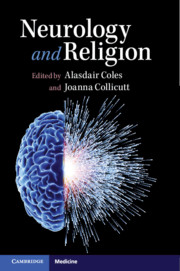Book contents
- Neurology and Religion
- Neurology and Religion
- Copyright page
- Contents
- Contributors
- Preface
- Part I The Neurological Study of Religion
- I.I The Natures of Neurology and Religion
- I.II Philosophical and Historical Issues
- Chapter 4 Embodied Cognition and the Neurology of Religion
- Chapter 5 Phenomenology, Neurology, Psychiatry and Religious Commitment
- Chapter 6 Philosophical Hazards in the Neuroscientific Study of Religion
- Chapter 7 The Glass Onion
- Chapter 8 Towards an Islamic Neuropsychiatry
- Part II Neurology and Religion
- Bibliography
- Index
- References
Chapter 4 - Embodied Cognition and the Neurology of Religion
from I.II - Philosophical and Historical Issues
Published online by Cambridge University Press: 28 October 2019
- Neurology and Religion
- Neurology and Religion
- Copyright page
- Contents
- Contributors
- Preface
- Part I The Neurological Study of Religion
- I.I The Natures of Neurology and Religion
- I.II Philosophical and Historical Issues
- Chapter 4 Embodied Cognition and the Neurology of Religion
- Chapter 5 Phenomenology, Neurology, Psychiatry and Religious Commitment
- Chapter 6 Philosophical Hazards in the Neuroscientific Study of Religion
- Chapter 7 The Glass Onion
- Chapter 8 Towards an Islamic Neuropsychiatry
- Part II Neurology and Religion
- Bibliography
- Index
- References
Summary
This statement by Nobel laureate Roger Sperry encourages us to consider the sort of information that is necessary to bridge the conceptual gap between psychological phenomena (such as religious behaviours and experiences) and the phenomenology of neurology. But what is it that needs to be taken into account in the gap between basic neurophysiology and the social and psychological phenomena of religiousness? Are religiousness and spirituality embodied physical phenomena at all? Answers to such questions are critical to establishing the basis upon which one should approach study of the impact of neurological disorders on religiousness and spirituality. What model of the relationship between body and mind is most fruitful for such study?
- Type
- Chapter
- Information
- Neurology and Religion , pp. 25 - 34Publisher: Cambridge University PressPrint publication year: 2019



